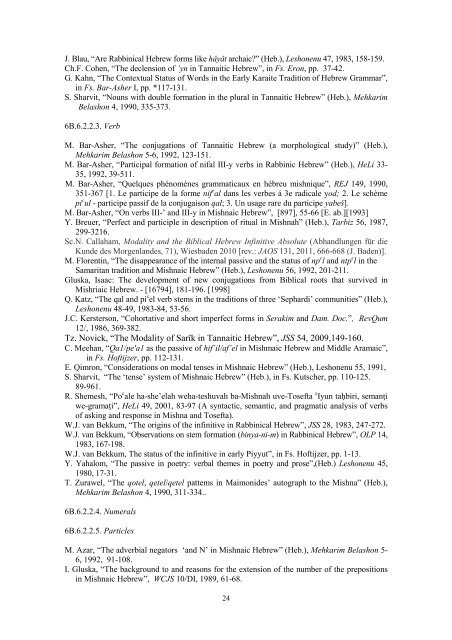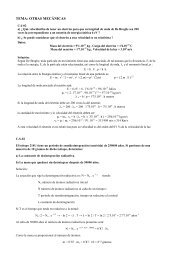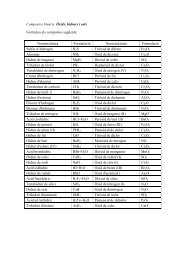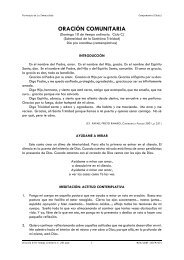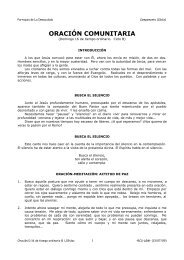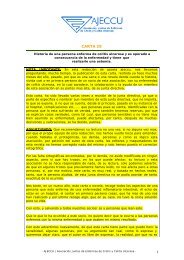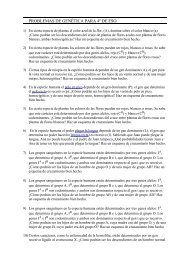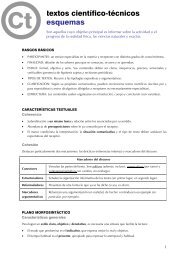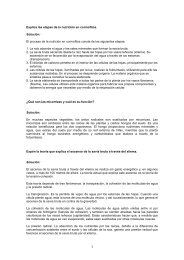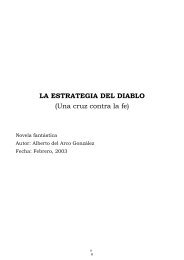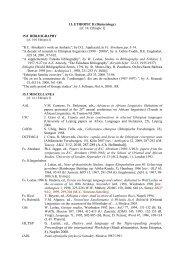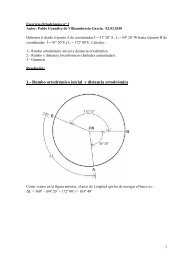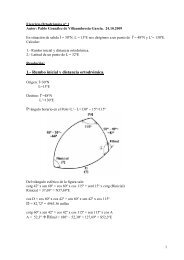BIB-SEM.6HB-dial _2010 - Telefonica.net
BIB-SEM.6HB-dial _2010 - Telefonica.net
BIB-SEM.6HB-dial _2010 - Telefonica.net
Create successful ePaper yourself
Turn your PDF publications into a flip-book with our unique Google optimized e-Paper software.
J. Blau, “Are Rabbinical Hebrew forms like hâyât archaic?” (Heb.), Leshonenu 47, 1983, 158-159.<br />
Ch.F. Cohen, “The declension of ’yn in Tannaitic Hebrew”, in Fs. Eron, pp. 37-42.<br />
G. Kahn, “The Contextual Status of Words in the Early Karaite Tradition of Hebrew Grammar”,<br />
in Fs. Bar-Asher I, pp. *117-131.<br />
S. Sharvit, “Nouns with double formation in the plural in Tannaitic Hebrew” (Heb.), Mehkarim<br />
Belashon 4, 1990, 335-373.<br />
6B.6.2.2.3. Verb<br />
M. Bar-Asher, “The conjugations of Tannaitic Hebrew (a morphological study)” (Heb.),<br />
Mehkarim Belashon 5-6, 1992, 123-151.<br />
M. Bar-Asher, “Participal formation of nifal III-y verbs in Rabbinic Hebrew” (Heb.), HeLi 33-<br />
35, 1992, 39-511.<br />
M. Bar-Asher, “Quelques phénomènes grammaticaux en hébreu mishnique”, REJ 149, 1990,<br />
351-367 [1. Le participe de la forme nif c al dans les verbes á 3e radicale yod; 2. Le schème<br />
pi c ul - participe passif de la conjugaison qal; 3. Un usage rare du participe yabeš].<br />
M. Bar-Asher, “On verbs III-’ and III-y in Mishnaic Hebrew”, [897], 55-66 [E. ab.][1993]<br />
Y. Breuer, “Perfect and participle in description of ritual in Mishnah” (Heb.), Tarbiz 56, 1987,<br />
299-3216.<br />
Sc.N. Callaham, Modality and the Biblical Hebrew Infinitive Absolute (Abhandlungen für die<br />
Kunde des Morgenlandes, 71), Wiesbaden <strong>2010</strong> [rev.: JAOS 131, 2011, 666-668 (J. Baden)].<br />
M. Florentin, “The disappearance of the internal passive and the status of np c l and ntp c l in the<br />
Samaritan tradition and Mishnaic Hebrew” (Heb.), Leshonenu 56, 1992, 201-211.<br />
Gluska, Isaac: The development of new conjugations from Biblical roots that survived in<br />
Mishriaic Hebrew. - [16794], 181-196. [1998]<br />
Q. Katz, “The qal and pi c el verb stems in the traditions of three ‘Sephardi’ communities” (Heb.),<br />
Leshonenu 48-49, 1983-84, 53-56.<br />
J.C. Kersterson, “Cohortative and short imperfect forms in Serakim and Dam. Doc.”, RevQum<br />
12/, 1986, 369-382.<br />
Tz. Novick, “The Modality of Sarîk in Tannaitic Hebrew”, JSS 54, 2009,149-160.<br />
C. Meehan, “Qa1/pe'a1 as the passive of hif´il/af´el in Mishmaic Hebrew and Middle Aramaic”,<br />
in Fs. Hoftijzer, pp. 112-131.<br />
E. Qimron, “Considerations on modal tenses in Mishnaic Hebrew” (Heb.), Leshonenu 55, 1991,<br />
S. Sharvit, “The ‘tense’ system of Mishnaic Hebrew” (Heb.), in Fs. Kutscher, pp. 110-125.<br />
89-961.<br />
R. Shemesh, “Po c ale ha-she’elah weha-teshuvah ba-Mishnah uve-Tosefta c Iyun taḥbiri, semanṭi<br />
we-gramaṭi”, HeLi 49, 2001, 83-97 (A syntactic, semantic, and pragmatic analysis of verbs<br />
of asking and response in Mishna and Tosefta).<br />
W.J. van Bekkum, “The origins of the infinitive in Rabbinical Hebrew”, JSS 28, 1983, 247-272.<br />
W.J. van Bekkum, “Observations on stem formation (binya-ni-m) in Rabbinical Hebrew”, OLP 14,<br />
1983, 167-198.<br />
W.J. van Bekkum, The status of the infinitive in early Piyyut”, in Fs. Hoftijzer, pp. 1-13.<br />
Y. Yahalom, “The passive in poetry: verbal themes in poetry and prose”,(Heb.) Leshonenu 45,<br />
1980, 17-31.<br />
T. Zurawel, “The qotel, qetel/qetel pattems in Maimonides’ autograph to the Mishna” (Heb.),<br />
Mehkarim Belashon 4, 1990, 311-334..<br />
6B.6.2.2.4. umerals<br />
6B.6.2.2.5. Particles<br />
M. Azar, “The adverbial negators ‘and N’ in Mishnaic Hebrew” (Heb.), Mehkarim Belashon 5-<br />
6, 1992, 91-108.<br />
I. Gluska, “The background to and reasons for the extension of the number of the prepositions<br />
in Mishnaic Hebrew”, WCJS 10/DI, 1989, 61-68.<br />
24


